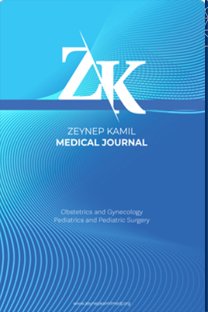Evaluation of blood pressures measured at the clinic and during exercise test in children
Evaluation of blood pressures measured at the clinic and during exercise test in children
___
- 1. Flynn JT, Daniels SR, Hayman LL, Maahs DM, McCrindle BW, Mitsnefes M, et al. on behalf of the American heart association atherosclerosis, hypertension and obesity in youth committee of the council on cardiovascular disease in the young. Update: Ambulatory blood pressure monitoring in children and adolescents: A scientific statement from the American heart association. Hypertension 2014;63(5):1116–35.
- 2. National High Blood Pressure Education Program Working Group on High Blood Pressure in Children and Adolescents. The fourth report on the diagnosis, evaluation, and treatment of high blood pressure in children and adolescents. Pediatrics 2004;114 Suppl 2:555–76.
- 3. Skrede T, Stavnsbo M, Aadland E, Aadland KN, Anderssen SA, Resaland GK, et al. Moderate-to-vigorous physical activity, but not sedentary time, predicts changes in cardiometabolic risk factors in 10-y-old children: The active smarter kids study. Am J Clin Nutr 2017;105(6):1391–8.
- 4. Braaksma P, Stuive I, Garst R, Wesselink CF, van der Sulius CK, Dekker R, et al. Characteristics of physical activity interventions and effects on cardiorespiratory fitness in children aged 6-12 years-sistematic review. J Sci Med Sport 2018;21(3):296–306.
- 5. Castro-Piñero J, José Perez-Bey A, Segura-Jiménez V, Aparicio VA, Gómez-Martínez S, Izquierdo-Gomez R, et al. Cardiorespiratory fitness cutoff points for early detection of present and future cardiovascular risk in children: A 2-Year Follow-up Study. Mayo Clin Proc 2017;92(12):1753– 62.
- 6. Massin MM. The role of exercise testing in pediatric cardiology. Arch Cardiovasc Dis 2014;107(5):319–27.
- 7. Cumming GR, Everatt D, Hastman L. Bruce treadmill test in children: Normal values in a clinic population. Am J Cardiol 1978;41(1):69–75.
- 8. Paridon SM, Alpert BS, Boas SR, Cabrera ME, Caldarera LL, Daniels SR, et al. Clinical stress testing in the pediatric age group: A statement from the American heart association council on cardiovascular disease in the young, committee on atherosclerosis, hypertension, and obesity in youth. Circulation 2006;113(15):1905–20.
- 9. Park MK. Park’s Pediatric Cardiology for Practitioners. 6th ed. Amsterdam, Netherlands: Saunders, Elsevier Inc.; 2014. 10. Schultz MG. Clinical importance of exercise blood pressure. Artery Res 2018;21(C):58–62.
- 11. Berger A, Grossman E, Katz M, Kivity S, Klempfner R, Segev S, et al. Exercise blood pressure and the risk for future hypertension among normotensive middle-aged adults. J Am Heart Assoc 2015;4(4):e001710. 12. Kim IK, Kang SH. Effects of aerobic exercise on blood pressure response during exercise. Letter to the editor. Iran J Public Health 2019;48(9):1738–40.
- 13. Caselli S, Serdoz A, Mango F, Lemme E, Seguı AV, Milan A, et al. High blood pressure response to exercise predicts future development of hypertension in young athletes. Eur Heart J 2019;40(1):62–8.
- 14. Ghosh R, Gates GJ, Schiller M, Walsh C, Pass R, Nappo L, et al. The prevalence of arrhythmias during exercise testing in children. J Am Coll Cardiol 2013;61 Suppl 10:E518.
- 15. Elsenmann JC, Laurson KR, Welk KJ. Aerobic fitness persentiles for U.S. adolescents. Am J Prev Med 2011;41 Suppl 4:106–10.
- 16. Creighton SE, Kovach J, Danduran M, Moker A, Dixon J, Simpson P. Normative values for pediatric patients undergoing the Bruce protocol in the modern era. J Am Coll Cardiol 2016;67 Suppl 13:958.
- 17. Hacke C, Weisser B. Reference values for exercise systolic blood pressure in 12-to 17-year-old adolescents. Am J Hypertens 2016;29(6):747– 53.
- ISSN: 1300-7971
- Yayın Aralığı: Yılda 4 Sayı
- Yayıncı: Ali Cangül
Anxiety, quality of life, eating behaviors, and sexual life in women with polycystic ovary syndrome
Gülfem BAŞOL, Sevil KİREMİTLİ, Tunay KİREMİTLİ, Paşa ULUĞ, Kemine UZEL
Evaluation of blood pressures measured at the clinic and during exercise test in children
Nurdan EROL, Çiğdem EROL, İlke AKTAŞ
Seroprevalence of Varicella-Zoster in the first trimester of pregnancy
Fırat TÜLEK, Bülent Berker, Alper KAHRAMAN
An overview of anaphylaxis in children
Effects of topical Povidone-iodine on thyroid function in surgical newborns
Ayşenur CELAYİR, Sırma Mine TİLEV, Burcu ARI, Tuba ERDEM
External anal sphincter repair by the overlapping method in obstetric anal sphincter injury syndrome
Filiz AKYÜZ, Sami AÇAR, Erman ÇİFTÇİ
Ectopic pelvic kidney: Prenatal diagnosis and management
Gürcan TÜRKYILMAZ, Bilal ÇETİN
Funda GÜNGÖR UĞURLUCAN, Cenk YAŞA, Sina ARMAN, Ekin İlke ŞEN, Nalan ÇAPAN, Gülşah GULA, Ayşe KARAN
